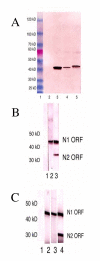Identification of a truncated nucleoprotein in avian metapneumovirus-infected cells encoded by a second AUG, in-frame to the full-length gene
- PMID: 15826312
- PMCID: PMC1087890
- DOI: 10.1186/1743-422X-2-31
Identification of a truncated nucleoprotein in avian metapneumovirus-infected cells encoded by a second AUG, in-frame to the full-length gene
Abstract
Background: Avian metapneumoviruses (aMPV) cause an upper respiratory disease with low mortality, but high morbidity primarily in commercial turkeys. There are three types of aMPV (A, B, C) of which the C type is found only in the United States. Viruses related to aMPV include human, bovine, ovine, and caprine respiratory syncytial viruses and pneumonia virus of mice, as well as the recently identified human metapneumovirus (hMPV). The aMPV and hMPV have become the type viruses of a new genus within the Metapneumovirus. The aMPV nucleoprotein (N) amino acid sequences of serotypes A, B, and C were aligned for comparative analysis. Based on predicted antigenicity of consensus protein sequences, five aMPV-specific N peptides were synthesized for development of peptide-antigens and antisera.
Results: The presence of two aMPV nucleoprotein (N) gene encoded polypeptides was detected in aMPV/C/US/Co and aMPV/A/UK/3b infected Vero cells. Nucleoprotein 1 (N1) encoded from the first open reading frame (ORF) was predicted to be 394 amino acids in length for aMPV/C/US/Co and 391 amino acids in length for aMPV/A/UK/3b with approximate molecular weights of 43.3 kilodaltons and 42.7 kilodaltons, respectively. Nucleoprotein 2 (N2) was hypothesized to be encoded by a second downstream ORF in-frame with ORF1 and encoded a protein predicted to contain 328 amino acids for aMPV/C/US/Co or 259 amino acids for aMPV/A/UK/3b with approximate molecular weights of 36 kilodaltons and 28.3 kilodaltons, respectively. Peptide antibodies to the N-terminal and C-terminal portions of the aMPV N protein confirmed presence of these products in both aMPV/C/US/Co- and aMPV/A/UK/3b-infected Vero cells. N1 and N2 for aMPV/C/US/Co ORFs were molecularly cloned and expressed in Vero cells utilizing eukaryotic expression vectors to confirm identity of the aMPV encoded proteins.
Conclusion: This is the first reported identification of potential, accessory in-frame N2 ORF gene products among members of the Paramyxoviridae. Genomic sequence analyses of related members of the Pneumovirinae other than aMPV, including human respiratory syncytial virus and bovine respiratory syncytial virus demonstrated the presence of this second potential ORF among these agents.
Figures




Similar articles
-
Nucleotide and predicted amino acid sequence-based analysis of the avian metapneumovirus type C cell attachment glycoprotein gene: phylogenetic analysis and molecular epidemiology of U.S. pneumoviruses.J Clin Microbiol. 2003 Apr;41(4):1730-5. doi: 10.1128/JCM.41.4.1730-1735.2003. J Clin Microbiol. 2003. PMID: 12682171 Free PMC article.
-
Development of a nucleoprotein-based enzyme-linked immunosorbent assay using a synthetic peptide antigen for detection of avian metapneumovirus antibodies in Turkey sera.Clin Diagn Lab Immunol. 2004 Mar;11(2):245-9. doi: 10.1128/cdli.11.2.245-249.2004. Clin Diagn Lab Immunol. 2004. PMID: 15013970 Free PMC article.
-
Chimeric recombinant human metapneumoviruses with the nucleoprotein or phosphoprotein open reading frame replaced by that of avian metapneumovirus exhibit improved growth in vitro and attenuation in vivo.J Virol. 2005 Dec;79(24):15114-22. doi: 10.1128/JVI.79.24.15114-15122.2005. J Virol. 2005. PMID: 16306583 Free PMC article.
-
Zoonotic Origins of Human Metapneumovirus: A Journey from Birds to Humans.Viruses. 2022 Mar 25;14(4):677. doi: 10.3390/v14040677. Viruses. 2022. PMID: 35458407 Free PMC article. Review.
-
Trends and Challenges in the Surveillance and Control of Avian Metapneumovirus.Viruses. 2023 Sep 20;15(9):1960. doi: 10.3390/v15091960. Viruses. 2023. PMID: 37766366 Free PMC article. Review.
Cited by
-
Deduced amino acid sequences surrounding the fusion glycoprotein cleavage site and of the carboxyl-terminus of haemagglutinin-neuraminidase protein of the avirulent thermostable vaccine strain I-2 of Newcastle disease virus.Vet Res Commun. 2007 Jan;31(1):105-12. doi: 10.1007/s11259-006-3290-8. Epub 2006 Dec 29. Vet Res Commun. 2007. PMID: 17195928
-
First report of Avian metapneumovirus type B in Iraqi broiler flocks with swollen head syndrome.Vet World. 2022 Jan;15(1):16-21. doi: 10.14202/vetworld.2022.16-21. Epub 2022 Jan 8. Vet World. 2022. PMID: 35369601 Free PMC article.
-
Proteome Analysis in a Mammalian Cell line Reveals that PLK2 is Involved in Avian Metapneumovirus Type C (aMPV/C)-Induced Apoptosis.Viruses. 2020 Mar 28;12(4):375. doi: 10.3390/v12040375. Viruses. 2020. PMID: 32231136 Free PMC article.
References
-
- Alexander DJ. Newcastle disease, other paramyxoviruses and pneumovirus infections. In: Saif YM, Barnes HJ, Glisson JR, Fadly AM, McDougald DJ, Swayne DE, editor. Diseases of Poultry. 11. Ames, IA: Iowa State Press; 2003. pp. 63–100.
-
- Jones RC. Avian pneumovirus infections: questions still unanswered. Avian Pathol. 1996;25:639–648. - PubMed
-
- Seal BS. Avian pneumoviruses and emergence of a new type in the United States of America. Anim Health Res Rev. 2000;1:67–72. - PubMed
Publication types
MeSH terms
Substances
LinkOut - more resources
Full Text Sources

